Official Name:
The name now used to designate this meteorite is Tucson. However, it has gone by many names during its tumultuous history, including Santa Rita, Tucson Ring, Ainsa, Irwin-Ainsa, and Carlton. These are the names of places or people who played a role in the recovery of fragments of the meteorite.
Location:
Puerto de los Muchachos, a pass in the Santa Rita Mountains, about 45 kilometres southeast of Tucson, Arizona, USA.
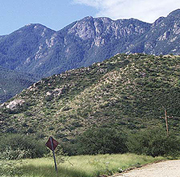
Enlargement
The Santa Rita Mountains, where the fragments from the Tucson meteorite are thought to have fallen. |
|
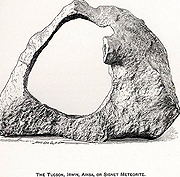
Enlargement
Drawing of the Tucson Ring made after the meteorite became part of the collection at the Smithsonian |
|
Fall or Find:
Find
Date:
The first written reference to the meteorite dates from 1845 but native people must have known about these masses of iron for centuries before that.
Mass Recovered:
975 kilograms
Number of Fragments:
Two massive fragments with the same composition were found. One is in the shape of a huge ring-this is the Tucson Ring (688 kilograms). The other fragment, Carleton (287 kilograms), is shaped like a bean. There are probably several other fragments still lying at the impact site.
Strewn field:
The distribution of the fragments from this multiple fall is not known. In fact, the exact place where it hit still remains a mystery.
Circumstances:
Nobody really knows who discovered the Tucson fragments. In 1850, one fragment was transported to the Mexican presidio in Tucson. The blacksmith there used the meteorite with the big hole in it as an anvil. One end of the meteorite is only 7 centimetres wide, while the other is 44 centimetres wide. The narrower part was buried in the ground at the blacksmith shop, and the wider end-over a metre long-was used as a work surface.
The second known mass, Carleton, was also transported from the mountains to Tucson to be used as an anvil. The first one must have worked really well if they decided to transport a second mass, too!
History:
The Mexican troops left Tucson in 1856, leaving behind the famous meteorites. In 1860, the Smithsonian Institution asked Lieutenant Irwin, an army physician and amateur naturalist in the area, to go to Tucson to recover the Tucson Ring meteorite. He found it, pulled it out of the ground, and entrusted it to a man who was to go to the coast and deliver it by ship to the museum. The man carried out his mission, but told the Smithsonian that his great-grandfather had discovered the meteorite. The family name, Ainsa, was given to the meteorite. Irwin attempted for many years to re-establish the truth before the error was finally recognized.
The blacksmith Ramon Pacheco was still using the bean-shaped fragment as an anvil when Colonel James Carleton confiscated it in 1862. It was transported to San Francisco for analysis, then put on display at an historical society. It was not until 1939 that the Smithsonian acquired it and reunited the two fragments.
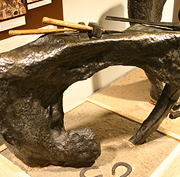
Enlargement
Replica of the Tucson Ring meteorite being used as an anvil. |
|
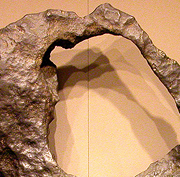
Enlargement
The two fragments on display at the National Museum of Natural History, Washington, D.C. |
|
Type:
Iron meteorite
Class:
Ungrouped ataxite
Composition:
Because it is an ataxite, Tucson contains a large proportion of nickel (9.6%). Yet Tucson's composition is not typical-silicates account for 8% of its volume, which is very high for an iron meteorite. Tucson may be the result of an impact between an iron asteroid and a stony asteroid.
The pierced fragment of the Tucson meteorite is unique among the large meteorites. A huge nodule of troilite must have occupied this cavity. When the parent body passed through the atmosphere, this less-resistant metal melted.
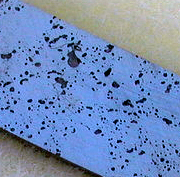
Enlargement
Slice of the Tucson meteorite. The dark spots are silicates. |
|
Scientific contribution:
The parent body of the Tucson meteorite cooled rapidly-there are no Widmanstätten figures present.
Comments:
Today, both fragments of the Tucson meteorite can be admired at the Smithsonian National Museum of Natural History, Washington, D.C.
Part of the Planétarium's collection:
No